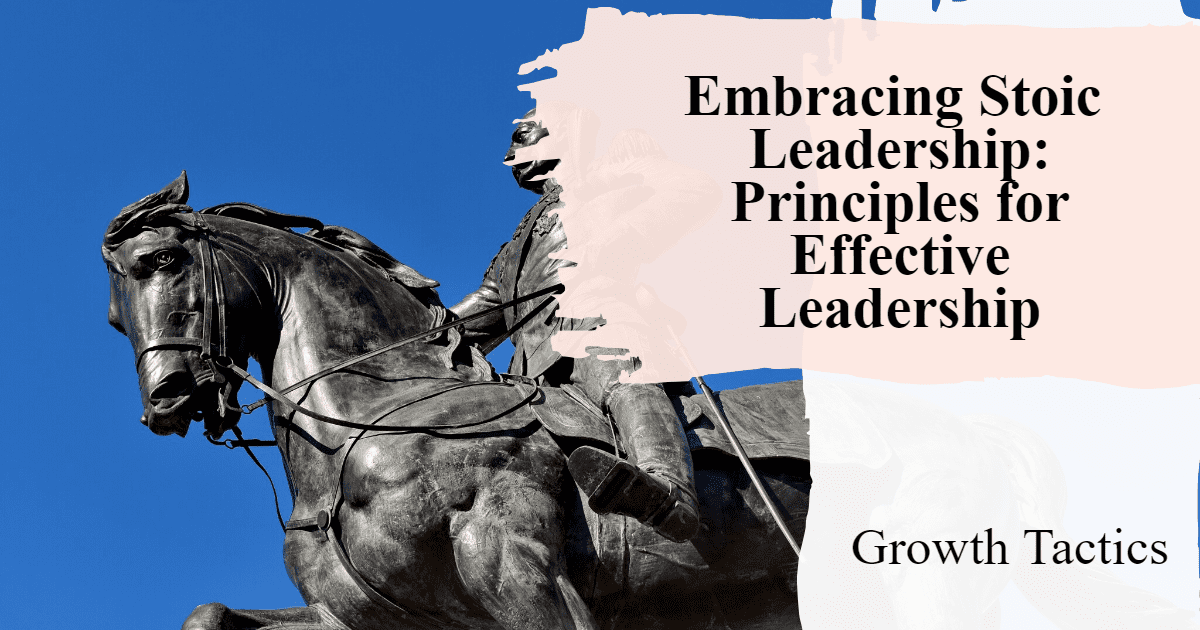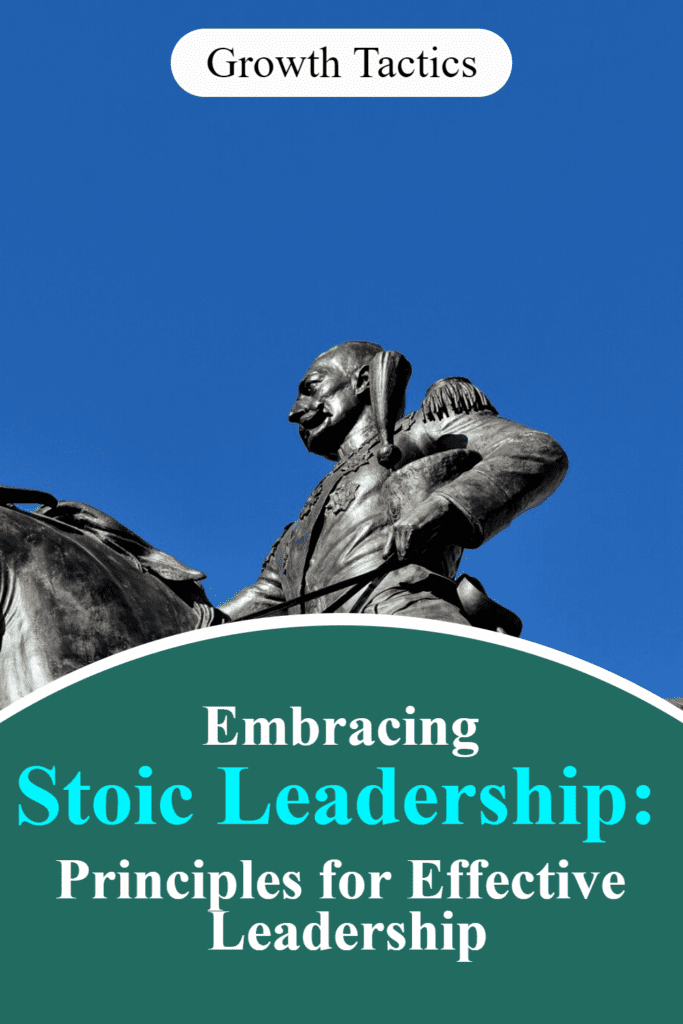Ready to explore stoic leadership? Great! In this article, we’ll dive into stoic philosophy and how it can transform your leadership style.
Stoicism isn’t just ancient history – it’s relevant and powerful today. Leaders like Marcus Aurelius and Seneca embraced stoicism, and their wisdom can guide us in our modern challenges.
We’ll uncover stoic principles, learn from stoic leaders, and discover how their teachings empower us to navigate challenges with grace and inspire those around us.
Intrigued? Let’s jump in and unlock the valuable principles of stoic leadership for your growth as a leader.
Jump To Section
Stoic Principles: Understanding the Core Tenets
Alright, let’s dive into the heart of stoic philosophy and uncover the core principles that guide stoic leaders like a trustworthy compass. Understanding these fundamental tenets will equip you with the tools you need to lead with resilience and virtue.
Virtue: Guiding Our Actions and Decisions
Ah, virtue—the North Star that leads us stoics on our path. It’s all about cultivating qualities like wisdom, courage, and justice. When we prioritize virtue, we make choices that align with our deepest values and lead with unwavering integrity.
As stoic leaders, embodying virtue becomes an integral part of our everyday lives. We strive to make decisions that are guided by reason and shaped by qualities that uplift us and those around us. Cultivating wisdom helps us make sound judgments, while courage empowers us to step outside our comfort zones and embrace calculated risks. And let’s not forget about justice—our drive to be fair and treat others with respect and dignity.
Imagine a world where leaders at every level prioritize virtue—where decisions are made not out of self-interest but with the well-being of all in mind. By placing virtue front and center, we create a ripple effect that spreads throughout our teams and organizations, fostering an environment of integrity and authenticity.
Self-Control and Self-Awareness: Mastering Ourselves
Ah, self-control and self-awareness—the dynamic duo that empowers us as stoic leaders. These qualities are like trusty sidekicks, helping us become the best version of ourselves and make choices rooted in virtue.
Mastering self-control allows us to resist impulsive reactions. It’s like having a superpower that enables us to pause, reflect, and respond thoughtfully rather than reacting in the heat of the moment. When we develop self-control, we free ourselves from the chains of impulsiveness, making decisions guided by reason and wisdom.
But self-control doesn’t work alone—it needs its partner, self-awareness, to truly thrive. Self-awareness involves developing a deep understanding of ourselves—our strengths, weaknesses, and emotions. It’s about recognizing our biases and blind spots and being open to feedback and growth. With self-awareness, we can lead with authenticity, making choices that align with our core values and positively impact those around us.
By harnessing the power of self-control and self-awareness, we become the masters of our own destinies, leading with intention and making decisions that bring out the best in ourselves and others.
Resilience: Embracing Setbacks as Opportunities
Life throws curveballs at us—unexpected challenges and setbacks that can shake us to our core. But as stoic leaders, we have an incredible power—the power to embrace these setbacks as opportunities for growth. It’s all about cultivating resilience.
Resilience is that inner strength that allows us to adapt, grow, and bounce back from setbacks with courage and determination. It’s not about avoiding difficulties, but rather about facing them head-on, learning from them, and coming out stronger on the other side.
When we embrace resilience, we view setbacks as stepping stones rather than insurmountable hurdles. We understand that failure is not the end—it’s simply a stepping stone toward future accomplishments. By cultivating resilience, we rise above adversity with grace and use it as fuel for personal and professional growth.
So, my resilient friend, remember that setbacks are not roadblocks—they are opportunities for us to discover our true strength and potential. Embrace them, learn from them, and let them propel you toward even greater heights.
Leading by Example: Igniting Virtue in Others
Leadership is not just about our personal growth—it’s about empowering and inspiring those around us. As stoic leaders, we hold an incredible influence on our teams, and by embodying stoic principles, we create an environment where virtue and success can thrive.
By leading by example, we become beacons of inspiration for our teams. Our actions speak louder than words—they set the standard for those around us. When we embody stoic principles like wisdom, courage, and justice, we create a positive ripple effect within our teams. Our authenticity and integrity inspire others to follow suit, leading to a culture of virtue and success.
When we lead by example, we show our teams what it means to prioritize virtue and lead with unwavering integrity. We encourage them to embrace resilience, develop self-control and self-awareness, and cultivate a sense of purpose. By creating such an environment, we empower those around us to unlock their full potential and become leaders in their own right.
So, remember these core tenets of stoicism—virtue, self-control, self-awareness, resilience, and leading by example—as you continue your journey as a stoic leader. These principles will serve as your guiding light, helping you navigate through the complexities of leadership with calmness, purpose, and accountability.
Challenges and Criticisms of Stoic Leadership: Addressing the Skeptics
Hey there! As we explore the world of stoic leadership, it’s important to acknowledge that like any philosophy, it has its fair share of challenges and criticisms. While stoic principles are incredibly valuable, they may not be everyone’s cup of tea. So, let’s dive into some of the common challenges and criticisms that skeptics raise, and I’ll provide some insights to address them.
Perceived Lack of Emotion: An Uphill Battle
One common criticism of stoic leadership is the perceived lack of emotion. Critics argue that stoics suppress or deny their emotions, which could hinder their ability to connect with and understand others on a deep level.
Here’s the thing: being a stoic leader doesn’t mean we’re emotionless robots. It means we strive to cultivate emotional resilience and maintain a calm and rational mindset even in the face of adversity. Stoic leaders acknowledge their emotions and use reason to regulate them, rather than being controlled by them.
By developing self-awareness, stoic leaders are able to understand their own emotions and those of others. This helps us empathize and connect with our team members, fostering an environment of trust and support. So, it’s not about lacking emotion—it’s about recognizing and managing emotions in a constructive way.
Adaptability vs. Stoic Stability: Finding the Balance
Another challenge skeptics raise is the tension between stoic stability and the need for adaptability in a fast-paced world. Critics argue that stoic leaders may be too resistant to change, hindering their ability to navigate complex and rapidly evolving environments.
While stoic philosophy does emphasize the importance of staying grounded and calm, it doesn’t mean we resist change at all costs. Stoics believe in being adaptable and embracing the things we cannot control. We distinguish between what’s within our power and what’s not, focusing our energy on what we can influence and accepting the rest.
By using reason and maintaining a calm mindset, stoic leaders are better equipped to assess and adapt to changing circumstances. We find a balance between staying true to our values and principles while navigating the ever-changing tides of the modern world.
Applicability in Leadership Contexts: A Matter of Perspective
Some skeptics argue that stoic principles may not be applicable in all leadership contexts. They question whether these ancient philosophies can truly be translated into effective leadership practices in today’s dynamic and diverse workplaces.
While it’s true that stoic philosophy originated in a different time and place, its principles remain timeless and adaptable. The core tenets of stoic leadership—virtue, self-control, resilience, and leading by example—can be applied in any leadership context, regardless of industry or organizational structure.
Stoic principles provide a strong foundation for ethical decision-making, fostering a positive culture, and leading with integrity. They serve as guiding principles, helping leaders navigate challenges, build meaningful relationships, and inspire others.
Stoic Leadership Styles: Unveiling Their Remarkable Characteristics
In this section, we’re going to explore the various stoic leadership styles. Just like there are different flavors of ice cream, there are various approaches to stoic leadership, each with its own unique characteristics. So, let’s dig in, shall we?
The Wise Sage: Leading with Deep Insight
Ah, the Wise Sage—a stoic leader who epitomizes wisdom and insight. This leadership style is all about harnessing a deep understanding of oneself, others, and the world to guide decision-making.
The Wise Sage demonstrates exceptional knowledge and critical thinking skills. They are the masters of reason, constantly seeking out new perspectives and challenging their own assumptions. They possess the remarkable ability to distill complex information into clear, actionable insights that inspire their teams.
By leading with wisdom, the Wise Sage fosters an environment where curiosity and learning flourish. They value intellectual growth, encourage open dialogue, and empower their team members to become lifelong learners. Insight becomes the cornerstone of their leadership approach, allowing them to make informed decisions that lead to success and personal growth.
The Steadfast Pillar: Resilient in the Face of Adversity
Next up, we have the Steadfast Pillar—a stoic leader who embodies unwavering resilience. This leadership style is all about remaining calm and composed during times of adversity while guiding others with an unshakable presence.
The Steadfast Pillar possesses tremendous emotional resilience. They stay grounded amidst the chaos, inspiring their team members to do the same. In the face of challenges, they respond with grace and fortitude, never letting setbacks define them.
By leading with resilience, the Steadfast Pillar sets an example for their team members. They encourage a growth mindset, believing that setbacks are not roadblocks but opportunities for personal and professional development. Their steadfastness inspires those around them to persevere and overcome obstacles with integrity and determination.
The Compassionate Guide: Empathy as a Guiding Light
Now, let’s explore the compassionate side of stoic leadership—the Compassionate Guide. This leadership style is characterized by an unwavering commitment to understanding, supporting, and empowering others through empathy.
The Compassionate Guide possesses exceptional emotional intelligence. They have a knack for connecting with their team members on a deep, personal level. They listen attentively, demonstrate genuine care, and strive to understand the unique challenges and perspectives of those they lead.
By leading with empathy, the Compassionate Guide creates a culture of trust and support. They foster an environment where individuals feel seen, heard, and valued. When team members feel understood and supported, they are more engaged, motivated, and willing to go the extra mile to achieve collective goals.
The Virtuous Role Model: Leading by Example
Last but certainly not least, we have the Virtuous Role Model—a stoic leader who embodies virtuous qualities and serves as a shining example for others to follow.
The Virtuous Role Model leads with unwavering integrity, demonstrating virtues such as honesty, fairness, and respect in all aspects of their leadership. They walk the talk, consistently aligning their actions with their deeply held values.
By leading with virtue, the Virtuous Role Model creates a culture of trust, authenticity, and accountability. They inspire their team members to embody their own set of virtues, fostering an environment of high moral standards and ethical decision-making.
Embrace Your Stoic Leadership Style
As you embark on your own stoic leadership journey, remember that these styles are not fixed categories but rather a spectrum. You might find yourself leaning toward one style more than others, or perhaps you blend elements of multiple styles to create your unique approach.
The key is to embrace your stoic leadership style authentically. Cultivate wisdom, resilience, empathy, or virtuous qualities in a way that resonates with who you are as a leader. Continuously seek growth, learn from your experiences, and inspire those around you to unlock their full potential.
So, my stoic friend, embrace your leadership style with confidence, lead with the virtues that resonate with you, and keep blazing a trail of greatness. The world needs more stoic leaders like you—ready to create positive change with wisdom, resilience, empathy, and virtuous actions.
Lead on, my friend, and let your unique stoic leadership style shine bright!








